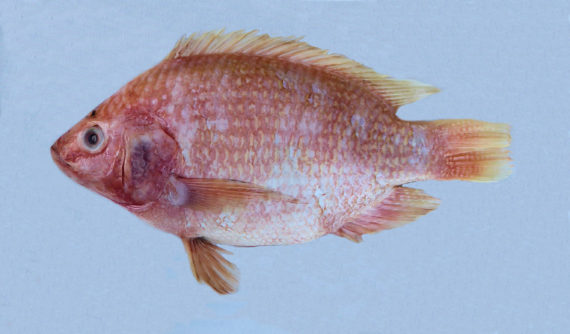Red Tilapia, Oreochromis aureus x Oreochromis mossambicus
 Red Tilapia, Oreochromis aureus x Oreochromis mossambicus: Commercial fish courtesy of an Asian Market, San Diego, July 2015. Length: 28 cm (11 inches).
Red Tilapia, Oreochromis aureus x Oreochromis mossambicus: Commercial fish courtesy of an Asian Market, San Diego, July 2015. Length: 28 cm (11 inches).
The Red Tilapia, Oreochromis aureus x Oreochromis mossambicus, is a member of the Cichlid and Tilapia or Cichlidae Family, that is also known as the Florida Red Tilapia and Red Yumbo and in Mexico as tilapia rojo. It is a hybrid of the Blue Tilapia, Oreochromis aureus and the Mozambique Tilapia, Oreochromis mossambicus that has been developed as food fish. Globally, there are thirty-two species in the genus Oreochromis, of which four are found in the majority of freshwater systems within Mexico.
The Red Tilapia has an overall “bluegill” profile with a body that are more deeply compressed than other tilapias. Pure bread species are a uniform red color and pinkish ventrally, but fade to a reddish-white upon death. They have a small head and mid-sized eyes. Their anal fin has 3 spines and 9 or 10 rays; their caudal fin is rounded; and, their dorsal fin has 15 to 18 spines and 10 to 13 rays with a long base. They have 16 to 22 gill rakers on their first arch and their lateral line is interrupted. Their body is covered with cycloid scales.
The Red Tilapia reaches a maximum 38 cm (15 inches) in length and 4.3 kg (9.5 lbs) in weight. They are very tolerant of brackish waters and of temperatures between 13oC (55oF) and 37oC (98oF). They are opportunistic omnivores consuming diatoms, invertebrates, small fry, and vegetation ranging from macroalgae to rooted plants to decaying plant material. They are active diurnally. The Red Tilapia is poorly studied with very limited information available about their lifestyle and behavioral patterns including specific details on age, growth, longevity, movement patterns, diet, habitat use, and reproduction. It is assumed that they are very similar to or identical to the Blue Tilapia and the Mozambique Tilapia from which they are derived.
The Red Tilapia has recently become a focused farmed species with many aquaculture facilities being retooled and dedicated to their production. They are relatively fast growing to a uniform size and have calm dispositions making their handling and transport facile. Although they are more difficult to farm than the Blue Tilapia, the Mozambique Tilapia, and the Nile Tilapia, they have attracted producers due to their enhanced marketability as their flesh color can command prices about twice that of the dark-colored tilapia. They are grown in fresh or salt water in cages, concrete tanks, and earthen ponds using semi-intensive and intensive systems. They can also survive and reproduce in relatively high levels of saline. Farming of Red Tilapia is more difficult on a cost basis compared to the Blue Tilapia, Mozambique Tilapia, or Nile Tilapia due to lower spawning success rates, lower egg production, lower fry survival rates, and lower total yields. They are not as cold resistant as other tilapia requiring water temperatures greater than 22oC (72oF)for survival, enhanced disease resistance, and reasonable growth rates. The survival rates of juvenile fish is also an issue as they are about 50% of the level of the darker colored tilapia which is mainly attributed to bird predation (due to their high visibility) and cannibalism. Also the constant inbreeding of Red Tilapia has generated strains that are weak with poor egg and fry variability. Farmers are not able to quickly fix this problem as they are poorly educated and don’t have access to essential scientific testing protocols.
The Red Tilapia is found in all Mexican freshwater systems and if not currently present in a specific body of water they will be there shortly.
The Red Tilapia cannot be confused with any other species due to its uniform coloration, however, several different strains of the Red Tilapia exist globally.
The Red Tilapia is farmed on a limited but with expanding efforts in Mexico. They are sold primarily in the United States, gutted and scaled. They are believed to have whiter meat and fewer issues with off-flavored meat. Consumers are willing to pay a higher price for Red Tilapia but they have to be sold with the skin on to take advantage of their attractive red coloration. Filleted Red Tilapia has no market advantage over the same product from Nile Tilapia. Small live Red Tilapia are readily available on the internet in batches of 100 one-inch fish at a price of approximately $1.00 per fish. Due to the difficulty to grow and propagate these fish, they are not recommended for first time small scale aquaculturists.